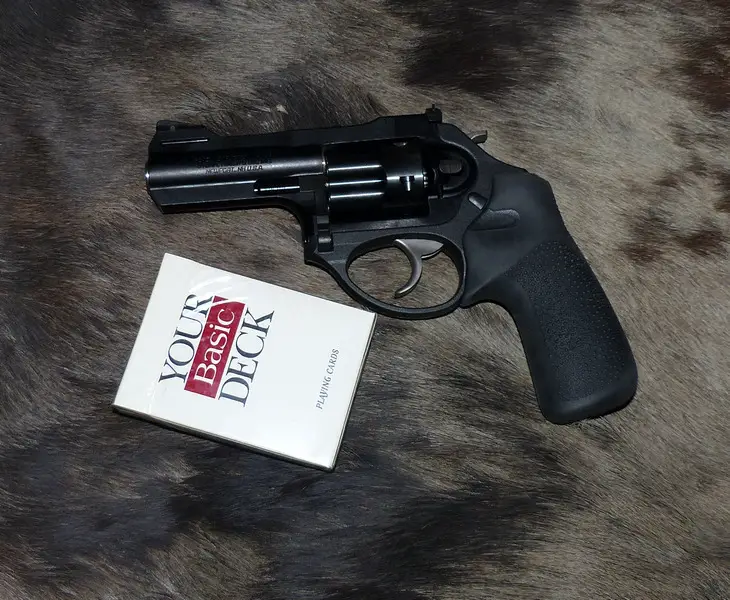


Review: 2015 Ruger LCRx .38 Special Revolver

The new for 2015 Ruger LCRx revolver builds upon the popular LCR series of revolvers, coming with an exposed hammer, adjustable sights, and a bit longer 3 inch barrel. The factory published specifications are as follows.
Model
Number: 5431 | Caliber: 38 Spl +P
Finish: Matte Black, Synergistic Hard Coat
Grip: Hogue® Tamer™ Monogrip®
Front Sight: Replaceable, Pinned Ramp
Rear Sight: Adjustable Black Blade
Barrel Material: Stainless Steel
Cylinder Finish: Ionbond Diamondblack™
Barrel
Length: 3.00"
Overall Length: 7.50"
Height: 5.80"
Width: 1.28"
Weight: 15.70 oz.
Capacity: 5
Twist: 1:18.75" RH
Grooves: 6
MA Approved & Certified: No
CA Approved: No
Suggested Retail: $545.00
The previously tested LCR has a 1.875 inch barrel. Standard data industry
data shows a muzzle velocity increase of about 125 fps with a .38 Special
for a 3 inch barrel vs. a 2 inch barrel. To cite a few examples, a Cor
Bon 110 grain JHP averages 675 fps from a 2 inch vented barrel, increasing
to 851 fps with a 3 inch barrel. The Cor Bon 110 grain DPX velocities
are 814 fps and 963 fps, and the Federal 125 grain Hydra-Shock averages
700 fps with a 2 inch barrel, but 831 fps with a 3 inch barrel. An 18%
percent velocity increase is a lot more than trivia, as far as I'm concerned.
Compared to the integral fixed sight 1.875 inch LCR, this model adds only a couple of ounces, weighing in right at a pound unloaded. It also is still a fairly thin revolver at approximately 1-1/4 inches. The price is attractive as well, retailing at $545 with a street price in the $420 area.
Though the subject has been more than thoroughly covered, the .38 Special +P in general rates above the .380 ACP, but a clear notch back from the 9mm and .357 Magnum, although all four cartridges have essentially 9mm projectiles. One example is the current Remington Ultimate Defense loads, all with 4 inch barrel velocities: 940 fps MV for the .380 with a 102 grain bullet, 975 fps for the .38 Special (+P) with a 125 grain bullet, and 1125 fps for a 9mm Luger with a 124 grain bullet. Out of this 3 inch Ruger LCRx, you can expect 850 fps or so with a heavier bullet than you'd normally throw out of a .380.
In the concealed carry / home defense / self defense category of handguns, there is (to say the very least) a lot of personal preference in play. Some are intrigued by the notion of “power,” yet “powerful handguns” that aren't painful to shoot are far too bulky and heavy to be considered convenient carry firearms. How much weight and bulk you can tolerate is of course, up to you.
I'll tell you why I am impressed with this version of Ruger's LCR series and you can determine for yourself if this makes sense for your needs. There are several appealing things about revolvers. They are self-explanatory to use, there is no issue with stove-piping or limp-wristing, no one is inadvertently going to drop or loosen a magazine, there are no external safeties to fuss with, no silly “chamber loaded indicators” to obsess over, no potential for a slide biting your hand, and so forth. The 3 inch barrel is preferable over shorter barrels as it not only gives you better velocity, but also a longer sighting plane, less muzzle flip, and less muzzle flash. The obvious negative is lack of capacity, but at the same time better capacity 9mm semi-autos are often substantially heavier. My Glock 19 is right at two pounds when fully loaded.
As with previously tested LCR models, the LCRx has a wonderfully smooth double-action trigger pull. In single-action mode, the trigger breaks at 6 lbs. or so and is glass-rod level crisp. While the LCRx is no all-day plinker or target pistol, by any means, it is quite manageable to shoot and a bit softer-shooting than the 1-7/8 inch barreled model as well. The slight increase in weight vs. the prior LCR helps, but the larger Hogue grips seem to make the most difference. It is a practical all-around carry / nightstand / saelf-defense piece. Detailed range results to follow.
Copyright 2015 by Randy Wakeman. All Rights Reserved.

Custom Search


